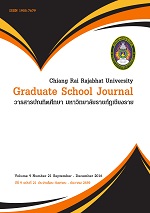汉语和泰语偏正复句连词对比及泰国学生使用 汉语偏正复句连词的偏误分析
Main Article Content
Abstract
通过汉语和泰语的比较发现,这两种语言偏正复句连词的分类上有相 同之处也有不同点。汉语偏正复句连词的分类共有六种,分别为:因果关系 类、转折关系类、假设关系类、条件关系类、目的关系类以及让步关系类。 泰语偏正复句连词的分类只有五种,分别为:因果关系类、转折关系类、假 设关系类、条件关系类以及目的关系类,泰语没有让步类的偏正复句连词。
泰国程逸皇家大学学生汉语偏正复句连词分类用法使用情况总错误率较 高,达到了67.22%。所考察的汉语偏正复句连词六种用法类型中,其中条件 关系偏正复句连词和目的关系偏正复句连词的错误率最高,错误率都高达错 误率都高达76.67%。紧接着是假设关系偏正复句连词错误率是73.34%,因果 关系偏正复句连词错误率是63.37%,转折关系偏正复句连词错误率是60%,最 后是让步关系偏正复句连词错误率是58.34%。
本论文对泰国学生偏正复句连词的使用偏误原因做了分析。从总体角 度来看,笔者认为泰国学生学习汉语偏正复句连词出现偏误的原因是多方面 的主要有以下四个方面:(1)汉语偏正复句连词本身复杂繁琐,难于理解 和记忆、(2)母语的负迁移、(3)教学方法问题、(4)学生背景知识不 足。
我们针对相关偏误原因提出了针对性的教学建议,在教学中应注意这 三个方面:(1)教师应该加强汉语和泰语对比分析来解释汉语偏正复句连 词的教学、(2)针对泰国学生学习汉语偏正复句连词应该多重视语义教学、 (3)多设计口语训练教学。
A Comparision of Complex Sentences between Chinese and Thai Languages and Error Analysis of Thai students in Using Chinese Complex Sentences
This research aimed to 1) investigate types and usage of complex sentences in the Chinese language 2) analyze the conditions and causes of problems arising from using Chinese complex sentences of Thai students and 3) seek guidelines on solving the problems of mistakes in using Chinese complex sentences of Thai students. The population and samples were 60 students comprising 20 second-year, 20 third-year, and 20 fourth-year students of Business Chinese Program, Uttaradit Rajabhat University. The research instrument was a questionnaire constructed by the researcher. The data was analyzed using percentage and content analysis.
With regard to the types of complex sentences, there were six types in the Chinese language – 1) causative sentences, 2) adversative sentences, 3) conditional sentences, 4) suppositive sentences, 5) purposive sentences, and 6) concessive sentences. However, there were five types of complex sentences in the Thai language – 1) causative sentences, 2) adversative sentences, 3) conditional sentences, 4) suppositive sentences, and 5) purposive sentences. All types of complex sentences were found in the Thai language except the concessive sentences.
With regard to the problems arising from using Chinese complex sentences of Thai students, it was found that overall mistakes made by all students were 67.22 percent. When mistakes of using each type of complex sentences were considered, it was found that the mistakes of using conditional sentences and purposive sentences were at 76.67 percent, suppositive sentences at 73.34 percent, causative sentences at 63.37 percent, adversative sentences at 60 percent, and concessive sentences at 58.34 percent respectively.
With regard to the causes of making mistakes when using Chinese complex sentences, the following causes were found – 1) difficulty and complexity of the sentences, 2) first language interference, 3) inappropriate teaching and learning methodology, and 4) students’ basic knowledge of Chinese. Regarding the guidelines on solving the problems of mistakes in using Chinese complex sentences of Thai students, it was suggested that 1) the instructor should explain and compare Chinese complex sentences with those of the Thai language clearly 2) the relation of clauses of Chinese complex sentences should be emphasized 3) conversations between teacher and students should be offered for frequent practice.
Article Details
บทความที่ได้รับการตีพิมพ์เป็นลิขสิทธิ์ของวารสารมหาวิทยาลัยราชภัฎเชียงราย
ข้อความที่ปรากฏในบทความแต่ละเรื่องในวารสารวิชาการเล่มนี้เป็นความคิดเห็นส่วนตัวของผู้เขียนแต่ละท่านไม่เกี่ยวข้องกับมหาวิทยาลัยราชภัฎเชียงราย และคณาจารย์ท่านอื่นๆในมหาวิทยาลัยฯ แต่อย่างใด ความรับผิดชอบองค์ประกอบทั้งหมดของบทความแต่ละเรื่องเป็นของผู้เขียนแต่ละท่าน หากมีความผิดพลาดใดๆ ผู้เขียนแต่ละท่านจะรับผิดชอบบทความของตนเองแต่ผู้เดียว

